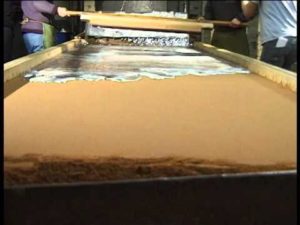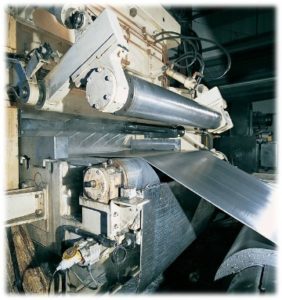A brief history of lead – 3 of 3 parts
A brief history of sheet lead production – Part 3
Sheet lead production today is achieved using one of 3 methods.
- Sand Casting
- Machine Casting
- Milling / Rolling
Sand Casting
Molten lead is poured over a smooth bed of sand and the lead spread around to create the desired thickness. As the lead cools it solidifies into a sheet with the surface in contact with the sand having a rough textured finish.

This is one of the earliest forms of sheet lead production used by the Romans and Medieval workers. It is still used today although in limited capacity by specialist manufacturers.
Machine Casting
Invented in the 1950s this production method is relatively modern compared to the long history of lead use. A large, cold metal drum is rotated in a bath of molten lead, as the lead solidifies it is drawn off the drum in a smooth sheet. The thickness of the sheet can be controlled by altering the speed of rotation, the depth the drum is submerged to and the temperature of the drum. This again produces cast lead in a sheet which is structurally different from milled lead.
Milling / Rolling
Milled lead is the product most commonly used in modern day building work. The process has been around since the industrial revolution and has been refined to produce a high quality product that is now controlled by British and European standards BS EN 12588.

A large block of lead is squeezed between rollers that gradually compress and stretch the lead until it reaches the desired thickness. The sheet is smooth on both sides and has a very consistent thickness and composition. Unlike the other processes that produce a cast lead this method produces a milled lead where the molecules are aligned differently which creates a much stronger better quality product.
At Leadworx we only use lead milled to BS EN 12588 which helps ensure the quality of the products is of a high standard.
Visit our store to see how lead is used in modern products.


